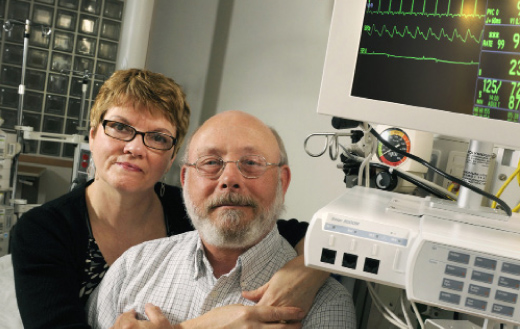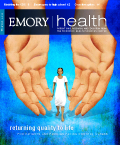Saving lives, while families look on
For family members awaiting news of a loved one’s struggle with cardiac arrest, the chasm between the hospital waiting room and the patient’s room has been far and wide.
But now in a dramatic change to bring more transparency to patients and families, Emory Healthcare is providing family members access to their loved ones during life-saving procedures.
Linda Hockman of Atlanta (above) experienced the change first-hand last June when her husband, Lee, came to Emory University Hospital with severe abdominal pain. When he slipped unexpectedly into cardiac arrest, she was able to remain only a few feet away from Lee in what she recalls being “the most surreal, yet comforting experience in my lifetime.
“I never felt like there was panic or loss of control—even though it was clear that Lee’s condition was continuing to worsen,” says Hockman, who is herself a nurse.
Yet when her husband’s heart stopped beating, she suddenly felt the entire environment of the room changed. “I recall that moment as being nothing short of controlled chaos,” she says. “Doctors and nurses were coming and going, and everything seemed to be frantic. The main doctor was watching over what was happening with my husband directly in front of him and directing things very calmly. A hospital chaplain came in to speak with me, and other doctors and nurses (including a dialysis specialist) were there because Lee’s kidneys were beginning to fail. Throughout this entire event, I was constantly being told about what was going on, why they were doing what they were doing to save Lee’s life, even though we still had no idea why he was crashing in the first place.”
At one point, Hockman felt the need to step out and collect her thoughts and emotions. After Lee was resuscitated and stabilized, she was back in the room, which looked, in her words “as if it was hit by a massive earthquake. There was equipment, paper—you name it—on the floor, physical evidence of the battle that had just taken place there to save Lee. But suddenly, everything felt serene. Good. I was at peace, and I had Lee still with me.”
Elaine Puckett, a local church minister and a member of Emory’s Patient-Family Advisory Council, stayed by Hockman’s side throughout the ordeal. “Not everyone would want to be in the same room under those circumstances,” Puckett says, “but many people do. It is natural that people want to know what is being done in such frightening and life-altering circumstances, and we are hoping that this becomes a normal part of the culture within our own hospitals and those across the country.”
Emory’s shift to establish a transparent culture, bringing patients and family into the care team, has been one of the system’s top priorities, says Hal Jones, Emory’s director of care transformation. “For the family, it creates a greater appreciation for the efforts taken to save a life under extraordinary circumstances. It creates a sense of partnership, instead of separation. And it provides family members with either a sense of closure or active accomplishment of being there throughout.” —Lance Skelly



